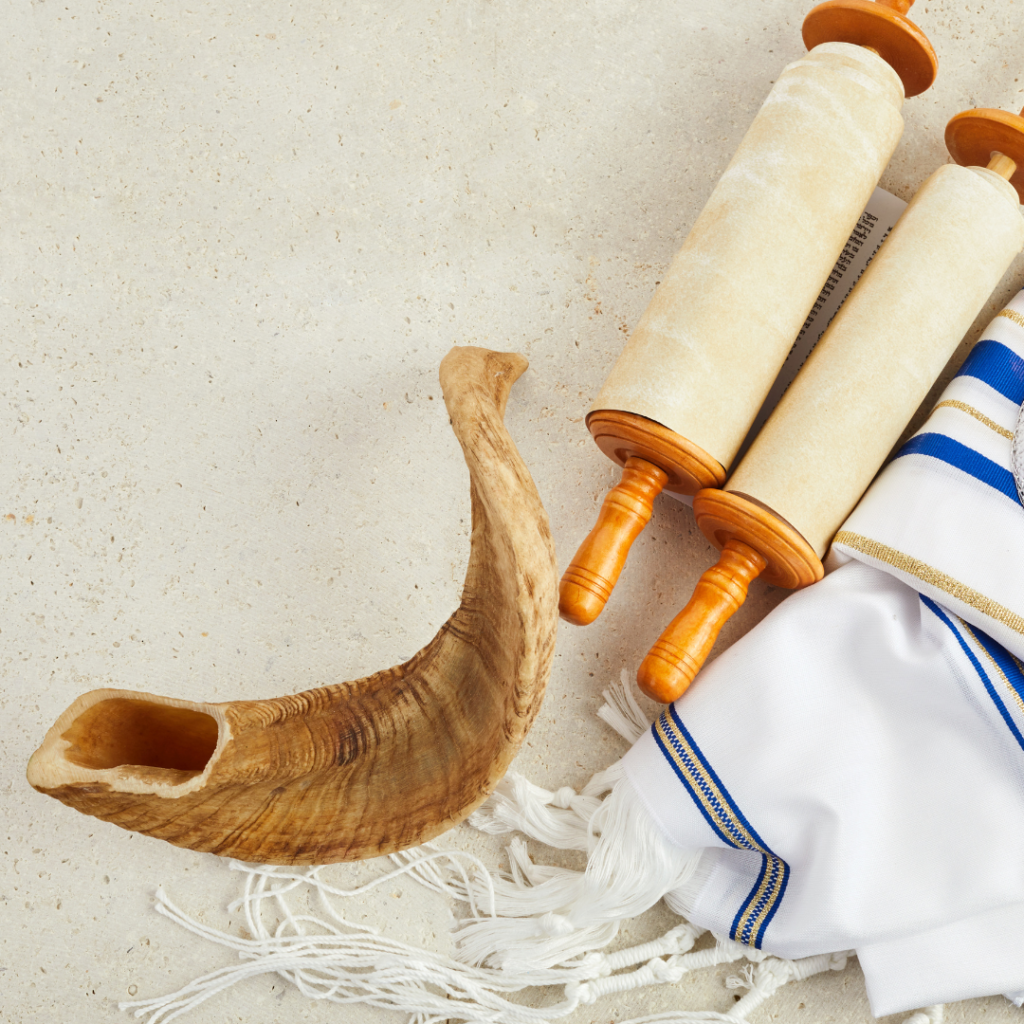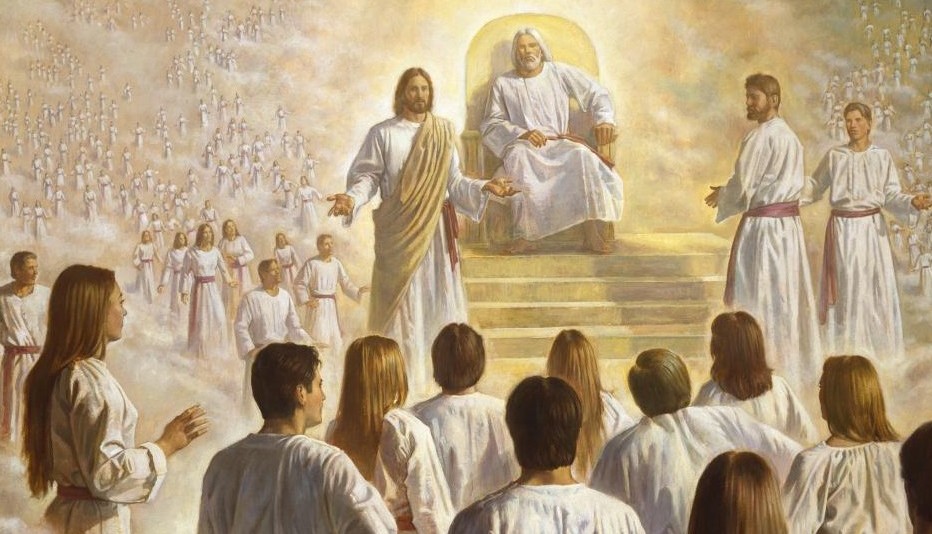
The Passion of Christ and the Cosmic Covenant of Peace
Written by Alisa McHarness
Cosmic: Of or relating to the cosmos, the extraterrestrial vastness, or the universe in contrast to the earth alone. Of relating to, or concerned with, the abstract spiritual or metaphysical. Characterized by greatness especially in extent, intensity, or comprehensiveness.
This month the Christian community worldwide will be remembering and observing the events of Holy Week, starting March 24 with Palm Sunday and ending March 31 with Easter. This month is also the anniversary of the dedication of the Kirtland Temple, on March 27, 1836. Because the goal of my series this year is to draw connections between the Church established by Christ in the first century and the Church re-established by Christ in the 19th century, I thought I would examine what connections can be drawn between Holy Week and the services of the Temple.
As I began my research, it appeared initially that I had set myself an impossible task, as there is very little that has been written modernly drawing a connection between the last week of Christ’s life and the temple building itself. Yet as I continued to read, I discovered compelling
connections to the Atonement and the Jerusalem temple rituals of the Day of Atonement, Yom Kippur. Quite a bit has been written about the connections between Passover and Easter [1], for obvious reasons, but it is interesting to note that the Passover sacrifice does not atone for sin, atonement is made on Yom Kippur.
Yom Kippur was understood at the time of the first and second temples to have important messianic implications that are not often talked about in connection with the work of Christ in his final week. However, a connection with Yom Kippur appears to have been explicitly understood in the first couple centuries of the church. The first parallel of many that I found is that “the service of this holy day (Yom Kippur) was the only one in the [Holy Temple] that was fully and sequentially carried out by one specific individual: the [High Priest]” [2], just as the events of Holy Week would ultimately be carried out and accomplished by Christ alone who is our High Priest. Much of the research I use in this article regarding the symbolism of the Temple and Yom Kippur is taken from the work of Margaret Barker. “Over the course of the last twenty-five years, she (Margaret Barker) has argued that Christianity arose not as a strange aberration of the Judaism of Jesus’s time but rather as a legitimate heir of the theology and ordinances of Solomon’s Temple” [3]. Because there is simply too much material to cover, I will be focusing at this time on the ancient myth that underlies Yom Kippur, the rituals of the Jerusalem temple, and the Passion of Christ [4].

The Cosmic Covenant of Peace
In her work, Margaret Barker attempts to reconstruct the beliefs of the first temple as it was
before King Josiah’s reforms through careful readings of texts written by those who fled or protested the reforms [5]. The underlying myth proposed by Margaret Barker of the creation of what she calls the “Cosmic Covenant of Peace” or sometimes the “Eternal Covenant”, sets the stage for why the Atonement is necessary and how it is to be affected at the cosmic level; that is outside of time, space, and encompassing all of creation. Roughly outlined, the story goes like this:
At the beginning El Elyon and his consort Wisdom created the heavens and the Sons of God, they also created the earth and mankind to fill it. Wisdom wove into creation the Eternal/Cosmic Covenant, called the Covenant of Peace, and all of creation is held together by her net of the covenant. There were some among of the Sons of El Elyon, lead by the angel Asa’el, who lusted after the daughters of men and conspired together to transgress the laws of Heaven. They took for themselves wives from among the daughters of men and taught mankind things that were forbidden, like how to make war on one another. Thus was the Eternal Covenant of Peace broken, chaos released, and creation polluted. Responsibility for repairing the covenant fell to the firstborn among the Sons of God, the LORD (Jehovah). At the great Day of Judgement the LORD will offer his own life and blood to repair Wisdom’s net, purify creation, and save the Sons of Light – the faithful among mankind, from the power of the Prince of Demons, Asa’el [6] [7] [8].
Due to the fragmentary nature of the texts from which this myth is compiled, it cannot be known what the full original myth was. We know there is also a covenant with Adam that is referenced in Hosea 6:6-8 that was transgressed, and we know from Moses 4 and Abraham 3 that there were other motivating factors for some of the Sons of God to rebel, and that the initial rebellion happened before the creation of Adam. Whatever the original myth was, it is not difficult to see elements of what was revealed to and taught by Joseph Smith, that were previously forgotten by the rest of Christianity or suppressed by Josiah’s reforms.

In this myth we can see that the purpose of the Atonement was to restore the original Cosmic Covenant of Peace that had been transgressed by men and angels. The word atonement in Hebrew is “kippur” and is usually translated as “cover”, as in covering a sin to hide it from God, however it is also legitimately translated as “to repair a hole, cure a sickness, mend a rift, make good a torn or broken covering” [9]. When applied to the reconstructed myth of the creation of the original covenant in this case, atonement is repairing the “net” of the covenant that binds creation together and cures the sickness that is sin plaguing creation and the souls of men; e.g. Isaiah 2:5 “The earth lies polluted under its inhabitants for they have transgressed the laws, violated the statutes and broken the everlasting covenant” [6]. This is how the early Christians understood it. “Thus Paul wrote of ‘the purpose set forth in Christ… to unite all things in him, things in heaven and things on earth’ (Eph. 1:10) and ‘through him to reconcile to himself all things, whether on earth or in heaven, making peace (shalom – make whole or complete) by the blood of his cross’ (Col. 1:20) [10].
The Temple
To understand the rituals and meaning of Yom Kippur, it is important to understand the function of the Jerusalem temple. One of the primary features of all temples is their highly symbolic nature that was seen as a physical manifestation of heavenly realities. “In the words of Hugh Nibley. . . the temple is a ‘scale model . . . (of) the universe,’ a place for taking bearings on the cosmos and finding one’s place within it” [3]. The temple at Jerusalem is unique from all other temples in the world in that its design, furnishings, and the ceremonies performed in it, were given by revelation in great detail to a prophet who carried a priesthood mantle “in the similitude of the Only Begotten”. Even with later changes made to the theology of the temple, during and following the time of Lehi, the symbolism of the temple and its ceremonies endured. The temple building was the most perfect representation available of the cosmos (the entire universe and realms of heaven), and the ceremonies were a perfect representation God’s plan for man’s redemption.

When we look at the symbolism of the Temple there are multiple levels of interpretation for how the temple is a “scale model” of the universe. In one view of the temple, the various areas and implements symbolize the creation of heaven and earth. The holy of holies is the creation of the heavens on day one, the realm of God and the angels. The veil was the creation of the firmament that divided the realms of heaven and earth on day two, the table of shewbread
represented the creation of land and vegetation on day three, and so on as you move through the temple to the outer court, representing day six. Alternatively, “The holy of holies, was the place of the LORD’s throne, but the great hall of the temple, was the Garden of Eden” [6]
making the outer court the region to which Adam and Eve were banished. In a third interpretation, “the three parts of the temple at Jerusalem correspond to the three cosmic regions. The lower court represents the lower regions (“Sheol,” the abode of the dead), the holy place represents the earth, and the holy of holies represents heaven” [11]. Underlying all these interpretations is the emphasis on the temple being the physical manifestation of the point where the throne of God and all of creation converge. Yom Kippur was the only time that any human, in the form of the high priest, could make the journey into the holy of holies so “the course taken by the Israelite high priest through the temple can be seen as symbolizing the journey of the fall of Adam and Eve in reverse” [12].
The Day of Atonement
When we understand that the Temple is a physical type of the entirety of creation and heaven, the rituals that are performed in it must also be understood as a physical manifestation of a heavenly reality. The ceremonies of Yom Kippur were the annual renewal of the Eternal/Cosmic Covenant. As “the temple was polluted by the sins committed elsewhere in the creation. . .the cleansing of the temple was the cleansing and reconsecration of the creation” [10].
The order of the Yom Kippur service happens as follows [2]:
- The high priest prays and confesses sin on behalf of himself and his family over the
head of a bull. - The high priest then draws lots over two goats and holds the lots over their heads. One says “Azazel” (aka Asa’el) and the other “HaShem” (aka YHVH/Jehovah). The two goats
are then marked with red wool to differentiate them. The goat for HaShem will be the sin
offering. - The bull is now dedicated to the sin of the entire Priesthood. “The Talmud explains that
first the Kohen Gadol (high priest) atones for his own sins and those of his family, and only afterwards does he make atonement for his colleagues…for it is better for an
innocent man to make rectification for those who are liable.” The bull is then killed, and
the blood collected. - The high priest collects coals from the altar in the outer court and carries the coals and the incense offering into the holy of holies and burns the incense before the ark/foundation stone. He offers a prayer on behalf of all Israel before the altar of incense
before exiting the temple. This is the moment of greatest tension as the congregation
waits to see if the high priest will successfully exit the holy of holies without being struck
down by God. - After the high priest exits the temple he retrieves the blood of the bull and returns to the holy of holies. He sprinkles droplets of the blood on the ark/foundation stone. Before exiting the temple the vessel that still contains blood is placed on a special tray beside
the veil and altar of incense. - The high priest returns outside and slaughters the goat marked for HaShem, he takes the blood into the holy of holies and follows the same procedure as the blood of the bull.
- Once outside the veil the high priest sprinkles droplets of the blood of the bull, then the goat, on the veil before mixing them thoroughly and sprinkling the blood on the altar of incense. Any remaining blood is poured out at the base of the altar of incense.
- The high priest returns outside and offers confession for the sins of the entire nation over the head of the remaining goat. This is the scapegoat, or the goat for Azazel, that is then taken by a warden 12 miles into the desert.
- The Mishnah reports “people pulled out the goat’s hair as it was led away (m.Yoma 6.4).
In the Epistle of Barnabas 42 there is a quotation from an unknown source about the scapegoat: ‘Spit on it, all of you, thrust your goads into it, wreathe its head with scarlet
wool and let it be driven into the desert’” [6]. - Booths are placed every mile to aid the warden of the goat to help him complete the long arduous journey, with the exception of the last 2 miles. Men from the booths would
accompany the warden each mile to assist him. - After arriving at a cliff, the crimson wool tied to the goat is divided into two pieces and the goat is pushed off a cliff. The warden then waits until dark to return to Jerusalem.
- After receiving confirmation from the desert of the fate of the scapegoat the high priest
then burns the bodies of the bull and the first goat outside the city. The service is
completed, the high priest removes his white garments, and the doors of the temple are shut.
The Role of the High Priest
The ceremonies of Yom Kippur were the one time of the year that the high priest entered the holy of holies and performed the rituals of the holy day almost entirely alone. The rituals of the holy of holies were understood to be “taking place outside time and matter, in the realm of the angels and the heavenly throne, and those who functioned in the holy of holies were more than human, being and seeing beyond time” [7]. For the services of Yom Kippur the high priest begins preparations one week in advance as he will be the only one performing all of the rituals and must know them by heart. On day of the holy day the high priest will dress in white without the usual richly ornamented vestments, he will ritually wash himself multiple times throughout the service, and will have two priests standing by who will assist in collecting the blood of the offerings—the first will take over the service in the event the high priest is disqualified for some reason, the second is the head of the family responsible for supplying the priests for that week of service [13]. Ten times in the course of the service, the High Priest will also speak out loud the name of God (YHVH or Jehovah) that is never used outside of the temple and the assembled congregation will prostrate themselves and respond with “blessed be the Name of His glorious kingdom, for ever and ever” [2]. Nephi likewise alluded to this high priestly role on Yom Kippur when he spoke about the importance of learning the name of the Lord and giving glory to God in 2 Nephi 6:4. The only ornamentation worn by the high priest was the gold plate tied to his forehead. “The high priest wore the name of the Lord on his forehead, inscribed on a golden plate (Ex. 28:36). Most translations say that he wore the words ‘Holy to the Lord,’ but Jesus; contemporaries
understood the Hebrew words differently. Aristeas, a visitor to Jerusalem in the first century before Christ, and Philo a few years later both record that the high priest simply wore the Name, the four Hebrew letters YHWH” [10].

By wearing the sacred Name on his forehead, the high priest was understood to take on the very identity of the LORD (YHVH) in the process of the ceremonies [6]. Origen, an influential
second century theologian who had connections with Jewish scholars, reported in his writings that the two goats used in the Yom Kippur service were understood as directly representing HaShem and Azazel. So when the High Priest, who was previously made pure by the blood of the bull, entered the Holy of Holies with the blood of the goat, he was entering as the LORD and bearing the blood of the LORD [10]. Yet the first “goat offered as the sin offering does not in fact take away the sin. Instead, this is somehow collected by the high priest, presumably as he performs the atonement rite, ‘carried’ and then transferred from the high priest on to the head of the Azazel goat” [6]. This is compelling because it means that even though the Eternal/Cosmic Covenant had been restored through the atonement ceremonies in the holy of holies the high priest was still bearing the sins of Israel; they had not yet been dealt with and they needed to be in order for the high priest to maintain his ritual purity.
The second phase of Yom Kippur was initiated when the high priest then transferred the sins of Israel to the goat Azazel. Why was the second goat seen to represent the fallen angel Azazel? There is an ancient school of Jewish mystical thought that originated in the century before Christ. One of the early prominent Rabbis associated with this movement is credited with intimate knowledge of secret temple traditions. “The school of R. Ishmael taught: Azazel because it obtains atonement for the affair of Uza and Aza`el. . . The affair of Asael and its
consequences is the major theme of 1 Enoch. . . In the Enochic tradition, the sin of the fallen angels results in the breaking of the ‘cosmic’ covenant and the corruption of the earth” [6]. The conclusion we could come to then is that, as the leader in breaking the Eternal/Cosmic Covenant, Azazel was ultimately responsible for the sin that resulted. By placing the sins of Israel on the goat Azazel before sending it out of Jerusalem and away from the people, the LORD, in the form of the high priest, was returning sin and corruption to where it came from.
The Great Atonement of Christ
The atonement then is ultimately a function of two goats, one for the LORD and one for Azazel. According to the Mishnah “they had to be identical. . . Between them, they carried the ritual. This is important; the two goats were two aspects of one ritual and cannot be separated. This was known to the first Christians who had no difficulty in comparing Jesus to both goats; he was both the sacrifice and the scapegoat” [6]. There are numerous parallels and connections that can be drawn between Yom Kippur and the passion of Christ, and there are aspects of the temple service and atonement that I have not even covered. Here are some of those parallels and I invite you to make your own connections:
- When Christ was baptized by John he was ritually immersed “to fulfill all righteousness”,
just as the high priest ritually washed to preserve his righteousness, or purity, for the
service of Yom Kippur. - Like the crowds in the temple who would prostrate themselves when the high priest spoke the name of the LORD, the crowds that welcomed Christ into Jerusalem recognized his High Priesthood when they declared “Hosanna (save us), blessed is he
who comes in the name of the LORD”. - When Christ was transfigured in Gethsemane there were two individuals who appeared
to support him – Moses who was a type of Christ in the “similitude of the Only Begotten” and Elijah who was likely a member of the priesthood. Just as the high priest was
supported by two others. - Like the high priest who passed through the temple regions that symbolized creation and the garden of Eden on his way to the holy of holies with the blood of a bull and goat, and while wearing the name of the LORD; Christ passed through Gethsemane to approach the throne of God with the incense of prayer, the blood of a pure priesthood, and his own blood for sin.
- From Gethsemane Christ was “handed over” to wardens who would take him out of Jerusalem. He would be tormented by the soldiers and harassed by the crowds but was also assisted along his way by others like Simon of Cyrene.
- Once outside of the city he was crucified, his garments divided, and his soul descended into the pit, carrying the sin and corruption of creation with him back to Azazel, the Prince of Demons, who orchestrated the breaking of the covenant.
“But Christ being come an high priest of good things to come, by a greater and more perfect tabernacle, not made with hands, that is to say, not of this building; Neither by the blood of goats and calves, but by his own blood he entered in once into the holy place, having obtained eternal redemption for us” (Hebrews 9:11-12).

It was by Christ’s suffering and obedience to the will of God the Father that he was made perfect and able to be the Great High Priest who redeems all of creation (Hebrews 5:6-10). This perfection is the blood of the bull, and he brought his own blood, symbolized by the goat, as the offering for sin into the presence of the Father where he “sweat as it were great drops of blood”. He passed through the “veil” between our world and the throne of God, successfully leaving the “temple” of heaven by his resurrection. For if he had not died on Golgotha as the scapegoat and the sins of creation had remained on him, and if he had remained in the realm of the dead under the power of the Prince of Demons, he would no longer qualify to stand in the presence of God the Father. So unlike the goats, Christ offered his life and blood before the throne in heaven yet still lives, meaning his offering remains permanently before God as the atonement that has repaired the net holding creation together. Understanding the atonement through the pattern provided by Yom Kippur brings so much clarity to how the atonement works that is not evident when we look at Passover alone. The early church in the first couple of centuries understood how the temple rituals witnessed of Christ, but once the temple was gone and all things Jewish were jettisoned from Christian worship and ritual, there was a great deal of knowledge that was lost. Plain and precious truths that were simply forgotten and, in some cases, intentionally erased. “Once a year on Yom Kippur, the Day of Atonement, Adam’s eastward expulsion from the Garden is reversed when the High Priest travels west past the consuming fire of sacrifice and the purifying water of the laver, through the veil woven with images of cherubim. Thus, he returns to the original point of creation, where he pours out the atoning blood of the sacrifice, reestablishing the covenant relationship with God” [3]. And once for all eternity Christ reversed the rift torn in the net of creation itself by the sacrifice of his suffering and perfect obedience, the purifying waters of baptism, through the veil of death dividing heaven and earth, returning sin and corruption to the Prince of Demons. He entered into the throne room of Heaven and stood before the Heavenly Parents and offered his own life to forever hold together the Cosmic/Eternal Covenant of Peace, bringing us back into perfect covenant relationship with God.
How delightful it is to study the scriptures, to discover the things kept hidden and forgotten, to demonstrate to others the purposes of the eternal patterns of the temple, the purpose of the laws of Moses, all things that were established from the beginning to reveal the Son of God to man. How beautiful are the covenants! Covenants of peace, of wholeness, of restoration, of grace and justice. Covenants of life eternal for creation and the Sons of Light. (My paraphrase of 2 Nephi 11:4-5)

Love What You're Reading?
Tune into this episode wherever you listen to podcasts. Want to get started?

Shatter Your Triangles
Sometimes we think we have an understanding of the Gospel, but when we take another look at what the scriptures, our paradigms can completely shift! Our Shattering Triangles team aims to help you deepen your testimony and doctrinal understanding to some of the more prominent questions found among members.

Up Your Preparedness Game
Our Honey + Lilies Blog is dedicated to helping you prepare for the days ahead. Want to get started? Click here.
